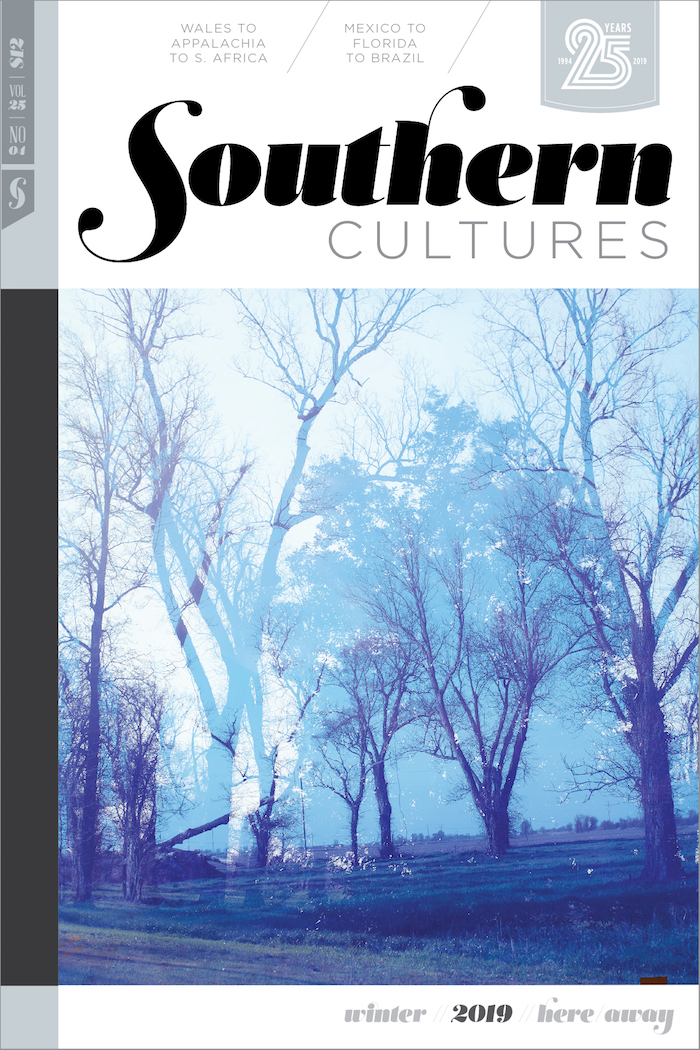“I love when I hear the sound of resistance, how the drum informs how people navigate space. The body reveals what’s happening in society.”
Home. That was what I felt when I first met Millicent Johnnie almost twenty years ago. We laughed too loudly to care, talked about food, and shared memories from our Louisiana upbringings. Now a choreographer who explores culture and human experiences through the vibrancy of moving bodies, Millicent has led a career that has blossomed internationally, from her choreography for the Public Theater’s play Party People in New York to her performance in Rio de Janeiro’s opening ceremonies for the 2016 Olympic Games.
As a dance studies professor at Florida State University, my research often takes me home to explore the rich movement legacies (especially social dance) of my native New Orleans. And as a historian and a white, cisgendered woman, my work centers around dance and power, especially in relation to gender and race. My appreciation of Millicent’s choreography prompted me to learn more about her Bamboula: Musicians’ Brew (2015), a work commissioned by the Cleo Parker Robinson Dance Ensemble in Denver, Colorado, for its forty-fifth anniversary season. Millicent and I join forces here for an in-depth exploration of Bamboula’s cultural legacies, including her thesis that American show business “excluded black people but it never ignored black culture.”1
In Bamboula, Millicent examines the connective threads between New Orleans’s African American Mardi Gras, particularly the Zulu Social Aid & Pleasure Club (SAPC), and Cape Town’s Kaapse Klopse (known as Coon Carnival under apartheid, now called Minstrel Carnival). As an auction block scene fades into a masked ball, Capetonian revelers move where Mardi Gras Indians just danced. A minstrel figure (outfitted in black bodysuit beneath satin suit, hat, and gloves, preventing audiences from determining the character or dancer’s race or gender) smoothly transitions each scene until, finally, a celebratory dancing ensemble emerges, armed with bouncing umbrellas, handkerchiefs, and tambourines. They peel back the curtains, revealing a roaring live band. In these final moments, music and dance revel together in second line jubilation.2
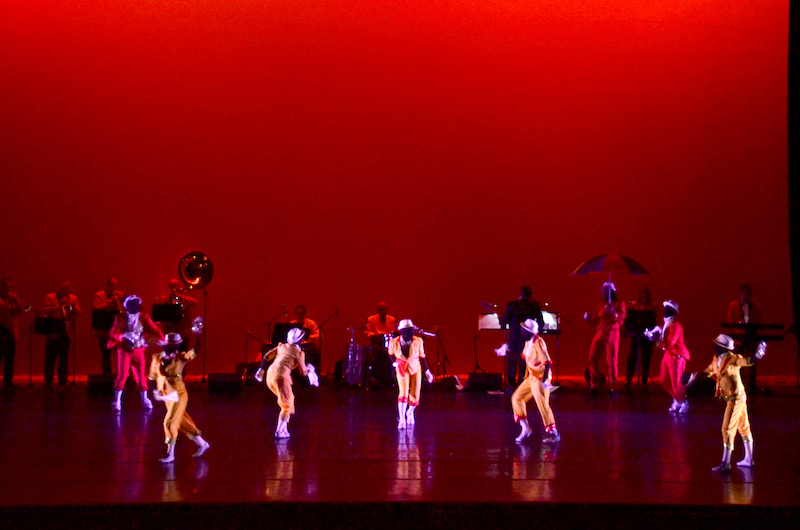
A transatlantic framework rooted in Millicent’s Louisiana background and her 2010 research trip to South Africa frames the project. Both traditions were born from a historical context of institutional slavery and segregation. We can trace Klopse’s loose origins to the early nineteenth century. The enslaved celebrated while masters slept off New Year’s festivities. After abolition in 1834, post-emancipation revelry functioned as a liberating expression of humanity. Over the years, Klopse has formalized with events leading up to the minstrels’ Carnival day parade through the city center, followed by musical competitions. City center parading is key. Starting at the edge of District Six, participants journey through the territory where they and their kin lived before apartheid—where they were forcibly removed in the 1970s—passing multiple touchstone places along their route, like City Hall, where Nelson Mandela gave his first public speech.3
This dramatization finds its echo in SAPC anniversary parades, where organizations dance past favorite social spots (bars, mostly) and members’ homes, contributing to a “collective ownership of the streets,” as anthropologist Helen A. Regis notes, “at least for the duration of their performance.” This is significant considering that many SAPC members do not own homes or businesses. Collectivity has long been at Zulu’s core. Early club histories tell of a group of black laborers inspired by a comedy skit who dressed up as “Zulus” (complete with lard can crown and banana stalk scepter for their king, William Story) and paraded on foot on Mardi Gras in 1909. Updated research reveals that early “Zulus” were also Benevolent Aid Society members and so participated in community uplift.4
In parading, music and costuming tie Zulu and klopse (“troupes”) together. Both reply on syncopated, driving drum beats. Klopse is deeply connected to goema (or ghoema), a drum and a musical style comprised of African, Asian, and European influences that eventually included Dixieland jazz. It exudes a highly syncopated beat.5 The goema drum is akin to the bamboula drum (and its accompanying beat), a bedrock of New Orleans’s Congo Square and, later, second line’s foundation.6
Both groups demarcate affiliation through bold, color-coordinated suits, matching hats and shoes, and embellishments-cum-dancing props—umbrellas and feathered fans to name a couple. Even more striking is that Zulu and the klopse both don blackface. Zulu members (exclusively African American until the 1980s) paint their faces in black and white with one exaggerated white eye. Clarence A. Becknell Sr., Zulu’s director of public relations, explained the signature look, asserting: “Zulu parade costumes bear no resemblance to the costumes worn by ‘blackface’ minstrel performers at the turn of the century. Zulu parade costumes more closely resemble and are designed to honor garments worn by South African Zulu warriors . . . Zulu has always been about celebrating African and African-American culture, strength, and pride.”7
Both groups demarcate affiliation through bold, color-coordinated suits, matching hats and shoes, and embellishments-cum-dancing props—umbrellas and feathered fans to name a couple. Even more striking is that Zulu and the klopse both don blackface. Zulu members (exclusively African American until the 1980s) paint their faces in black and white with one exaggerated white eye. Clarence A. Becknell Sr., Zulu’s director of public relations, explained the signature look, asserting: “Zulu parade costumes bear no resemblance to the costumes worn by ‘blackface’ minstrel performers at the turn of the century. Zulu parade costumes more closely resemble and are designed to honor garments worn by South African Zulu warriors . . . Zulu has always been about celebrating African and African-American culture, strength, and pride.”8
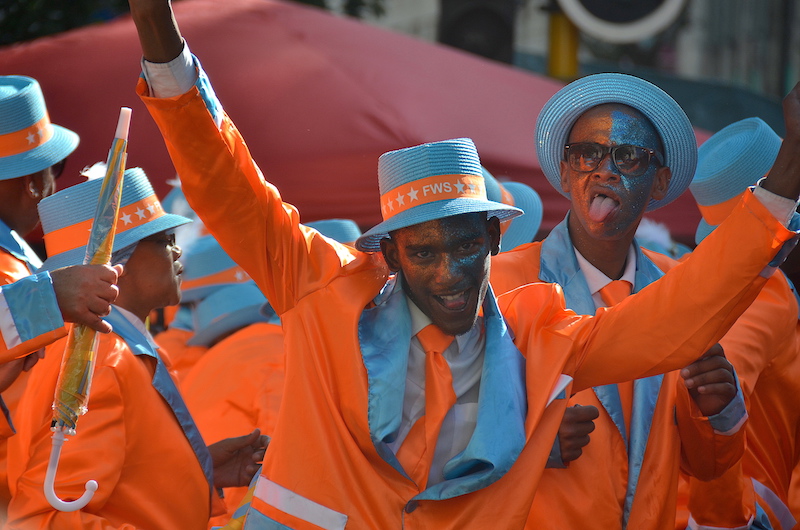
Blackface for Klopse and Zulu revelers becomes a tactic for claiming citizenship in historically oppressive spaces, an event—a procession—that by its nature imprints on participants “both their presence and their difference.” The cultural, generational, and embodied fortitude and creativity necessary to navigate this kind of performance is profound. Their performances were partially inspired by late-nineteenth-century visiting minstrel troupes, especially Orpheus McAdoo’s High Class Coloured American Minstrel Vaudeville Company. Some of McAdoo’s performers “formed the first Cape Coon troupe, the Original Jubilee Singers who were dressed in blue tailcoats and wore miniature top hats. Each had an eye circled in red.” Importantly, in their five years in Cape Town, they championed racial uplift politics that counteracted “blackface minstrelsy’s essentializing logic” of Africans as libidinous, lazy, and prone to thievery. While there, McAdoo also advertised himself as coloured, a “strategic act of self-classification” that scholar Chinua Akinaro Thelwell (drawing on Daphne A. Brooks) interprets as spectacular opacity—“anti-essentialist performative acts of various Black Atlantic pioneers who could not be easily fit into stereotypical racial categories.” As Brooks clarifies, spectacular opacity highlights the performer’s skill as they “confound and disrupt conventional constructions of the racialized and gendered body.” This becomes critical for Klopse members, perhaps why artist-scholar Nadia Davids uses the term “Black Capetonians” to signify “all citizens not classified as white under apartheid (including those classified as Indian, coloured, Cape Malay).” She explains: “This last act of political punctuation proceeds from the Black Consciousness Movement’s reactionary, productive, and inclusive rhetoric around blackness” that included “people of color living under colonialism and apartheid.”9
With a slew of product placement and social media photo shares, blackface is obviously not resigned to the past. These examples are mostly white blackface yet Zulu’s costuming (what some deem African American blackface) has also met backlash, coinciding with larger debates about enduring symbols of white power. Zulu released an official defense of their makeup shortly after the national firestorm erupted over a racist photograph of Virginia Governor Northam in blackface surfaced. Add to this the Take ’Em Down NOLA protestors linking Zulu’s makeup with Confederate statues (their platform: remove all of New Orleans’s symbols of white supremacy), and the media attack on Ann Tuennerman, a white woman invited to ride with Zulu who posted a selfie in full costume. Loyola University professor C. W. Cannon responded: “In the best traditions of carnivalesque practice, Zulu has expropriated racist representations and inverted them as a form of anti-racist resistance.” The fierce debate over Zulu’s costuming, he continued, “calls into question the extent to which black people should be allowed agency in representing their own experience; it also places limits on how black people themselves choose to enunciate anti-racist arguments.” It is within these contexts that Bamboula began.10
Millicent recently restaged part of Bamboula here at FSU, titling the iteration “NOLA All Up in My District Six.” She currently studies at the university’s prestigious College of Motion Picture Arts. Reuniting on the campus where we first met, we discussed the complexities of staging embodied history, what happens when we are somewhere else and find ourselves surrounded by home, and how dance is a fluid concept where ideas come alive and connect us.
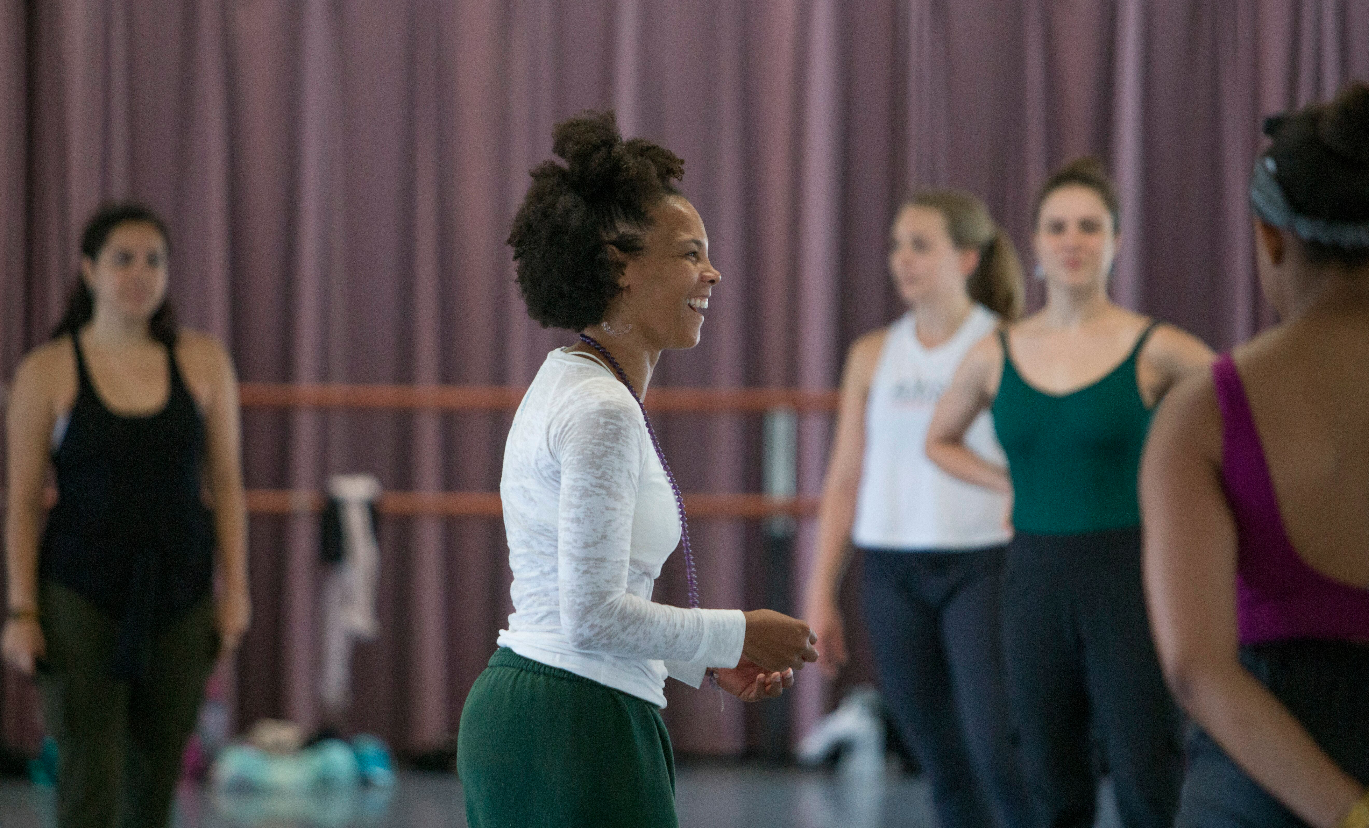
Millicent Johnnie in Conversation
Jennifer Atkins: What emerged as you explored connections between New Orleans and Cape Town in Bamboula?
Millicent Johnnie: I discovered Minstrel Carnival conducting research on sugarcane plantation communities in South Africa in 2010. In Durban, there was a mural with a minstrel dressed in gold, black, and white—in blackface—with a black umbrella. The minstrel was in a raffia skirt and it looked like what Zulu Social Aid & Pleasure Club members wear . . . and there was a fleur-de-lis next to all of that. I was like: How did New Orleans end up in Zululand?11
I went to the District Six Museum [in Cape Town] and saw a Carnival exhibit that looked at the history of Cape Town, Brazil, New Orleans, and the Caribbean. There was one plaque about Jubilee singers from the late 1800s [McAdoo’s troupe]. For me, that was enough to start my research.
I first met U.S. photographers who talked about Americanisms they found: the dress, similar to Social Aid and Pleasure Clubs; the blackface on black and brown bodies (because it’s only done in the coloured community); the goema drum paralleling the bamboula drum. There was also a percussionist there who sounded like the high hat sound in second line music when he played. I learned that, in Minstrel Carnival, there are categories of music you compete in; one is Dixieland.
JA: What other themes surfaced?
MJ: That there’s a certain association with place. Usually I’m dealing with people who have been historically marginalized and disenfranchised by governments or societal parameters. As a result, they create music and movement that takes over—or co-opts—space to claim it as their own. You have ancestral knowledge that comes with being forced to stay in the same place—generation after generation passing down traditions.
I love when I hear the sound of resistance, how the drum informs how people navigate space. The body reveals what’s happening in society. In Bamboula, we’re looking at simple things like the cakewalk, how it transitioned into the Charleston and informed other dances; the influences of the military around us [during World War II] and brass sounds—it changes the way we move and take over space. Because we are Indigenous and African peoples, especially [those] in New Orleans and the Cape Malay people, that percussion, that heartbeat, finds its way inside of cultural contexts. The body reflects that history.
I tried to look at what was happening in the Cape Town body—to learn the movement, hear the sounds—and then find connections with what I grew up dancing and listening to, images and ideals taught to me by my parents, my grandparents, and my great-great-grandparents, who were sharecroppers.
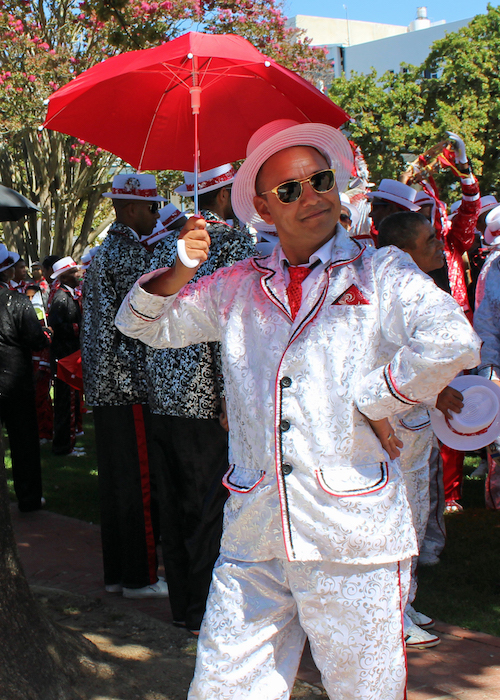
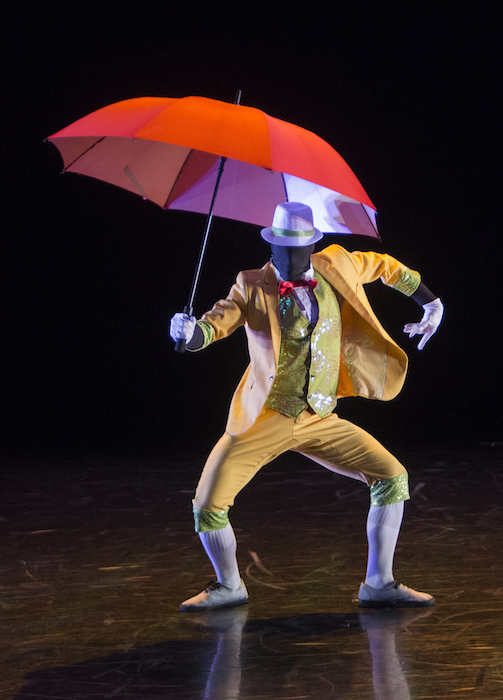
JA: How do some of these ideas manifest in Bamboula when you’re thinking about co-opting space?
MJ: Second line—the most obvious—but also Acadiana processions. In Acadiana, you might have a procession that leads to an open field. There’ll be a zydeco with music and dance. But, to get to that place, you have to process. We move through space to create space, in order to tell our stories.
In Bamboula, you’ll see second line and a little bit of buckjumping. Also, the way that the Carnival Indians manage space on Mardi Gras Day—tribe members protect each other moving through Tremé. Donald Harrison Jr., one of the original composers on the project, shared that his tribe was responsible for protecting him. If he doesn’t feel safe, there’s a certain formation they make to move forward and move on. If there’s a confrontation in the street, there’s a way they navigate space to let that other tribe know that they will not bow down; they will not turn.12
JA: And this is all about physicality, right?
MJ: Absolutely! There’s a section in Bamboula where I’ve taken that stance of the [Mardi Gras Indian] chief and placed it in the body of the Cape Town troupe captain. When I went to Cape Town, I interviewed several members who spoke about how this particular captain feels responsible for members. So, there’s a section where the captain talks about how you have to make sure that the band is ready, that the cloth that they use to construct the suit is correct, that all the extra design elements are together. If there’s a troupe member experiencing hardship, that captain takes responsibility. Donald Harrison said the same thing of his role as Big Chief: “If somebody in my tribe, in my community, is experiencing hard times, it is my responsibility to organize and take care of them.” I loved seeing those parallels.
JA: These New Orleans/Cape Town connections are clear. Could you talk about the ways that dance complicates seeing—or experiencing—South Louisiana identities?
MJ: A lot of unpacking needs to happen when looking at my work, which uses a vernacular vocabulary. Why? Because for so long a lot of the social dance forms from Louisiana were just that: social dance forms. I create avenues as to the why certain movements look the way that they look and trigger emotional responses. I use a lot of sound, because in Louisiana, music and dance are interconnected. So much of our dance—at least the dances that I gravitate to—are social dances and, historically, done to live music. There’s a live exchanging of energy in those spaces. I try to capture that.
I wanted to have partner dance in Bamboula because my first movement language was zydeco. We started with couples dancing and ventured into what we call the “Black Love duet.” With a couples dance, there’s got to be some type of equity and balance between the two partners. But when you’re met with challenges, there’s variables that happen to you, physically in space, but also metaphorically—you’re impacted by life. The duet turned into a bit of physical suggestion toward violence but also there were some tender moments that came from heart-to-heart, chest-to-chest connections.
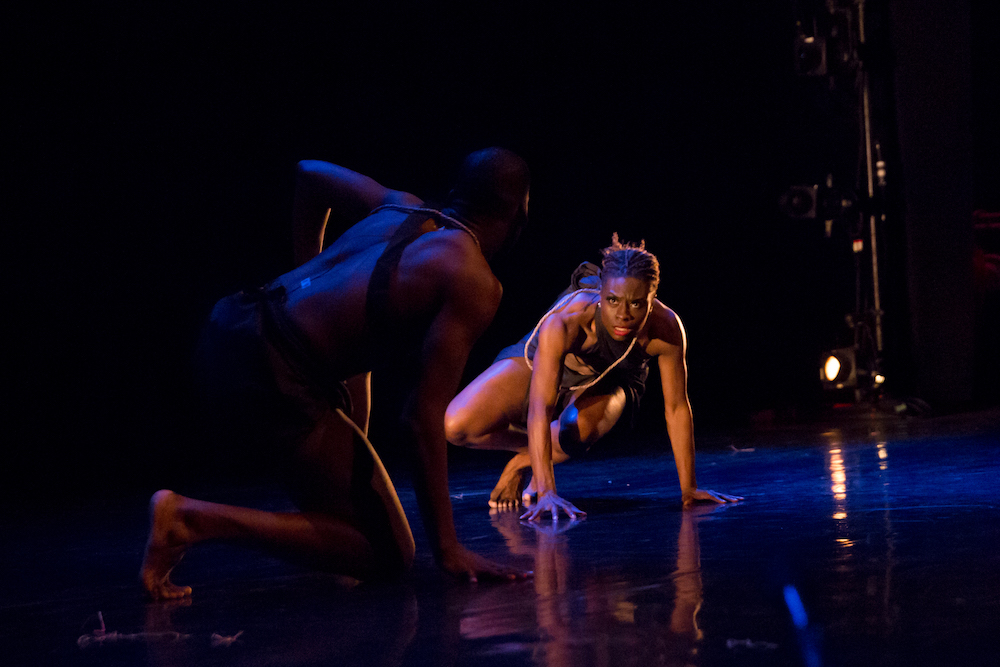
JA: That physicality illustrates that suffering lives next to perseverance, even joy. One issue you grapple with is the complicated, ongoing history of minstrelsy. Can you talk more about this?
MJ: When I first started, it was superficial: “There’s blackface in Cape Town; there’s blackface in New Orleans”—until I worked with Dr. Amma [Y. Ghartey-Tagoe] Kootin, a film studies and theater professor whose research is minstrelsy, specifically done on black bodies. She said, “Millicent, you presented us with the essence of blackness without the other layers so that we could experience: what is blackness and how did it manifest in New Orleans and Cape Town?” Dr. Amma’s specific point: minstrelsy done on black bodies is absolutely different from minstrelsy done on white bodies.13
JA: Coming from Louisiana, racial categorizations, like Creole, are multifaceted. But on a national level, of course, legal definitions have enforced black/white paradigms. When getting to the essence of blackness, how did you think through the differences between the two places?
MJ: Intra-Africana diasporic eyes on each other (and responses) is one of the beautiful things about Bamboula. What I saw in South Africa was something different and it shifted the minstrel narrative for me. My research and choreography foreground what I see when I see these forms in South Africa; Bamboula allows us to see across the diaspora just as myself and the dancers did and in this truth, I stand.
Black people have historically subverted racist stereotypes and used them as a means of protest and resistance. While some white folk may not see its revolutionary potential, it’s our right to wrestle, interrogate, and reconcile our history in ways we see fit. The way I saw fit in creating Bamboula was to design a work that allowed not only myself as a writer/director/creator to grapple with the complexity of performing blackface as a black performer, but to allow Cleo Parker Robinson and her company to grapple with it too. What we discovered is that there is a form of “baggage” we all carry behind seeing blackface from an American context. Part of the Bamboula process was how we used dance—form, movement, neutralizing but spot-on blackface costuming (especially)—to have folks enter deeper into the work and neutralize the baggage.
We had a Pittsburgh workshop with Dr. Amma for the second premiere. She called it “Bamboula is not Bamboozled” and gave us contexts for minstrelsy on black bodies, like how organizers/activists were able to inform folks that change was coming, even in the midst of the Jim Crow South. Now, I’m studying film. The other day my professor talked about vaudeville and minstrel shows as predecessors to film because that was how we’re able to reach mass audiences. That’s the part of history that was not taught to me. In doing “Undoing Racism” workshops and cultural sensitivity training, you start to understand power and your position of power. Those in a position of power oftentimes don’t want folks who have been historically marginalized and disenfranchised to know that they have access to significant power. That changed the narrative for me. The second premiere in Pittsburgh was drastically different.14
JA: How so?
MJ: In Denver, dancers in mime costumes faced mylar mirrors while seated on black wooden boxes. The audience watches the dancers miming applying makeup onto their faces.15
Then the creative team goes to the Zulu Social Aid & Pleasure Club ball. We see black and brown people dressed in formal gowns and tuxedoes—drinking champagne!—having the time of their lives. For one night, they experienced their idea of black Southern royalty. From there, we have our Dr. Amma experience and something clicks—we are constantly masking to take care of ourselves, to alter other people’s perceptions, to survive. And not only are we mentally and spiritually doing it, we’re physically doing it. We put the dancers into formal gowns and added masks to give an image of black bourgeoisie in New Orleans. It’s the same choreographic material, but now with more context. It solidified that we’re always trying to get to the other side; there’s this yearning for equity. If we have to put on a mask for one night in order to feel like, “Finally, we have access to economic power and status and that type of legitimacy!” then that’s what we’re going to do.16
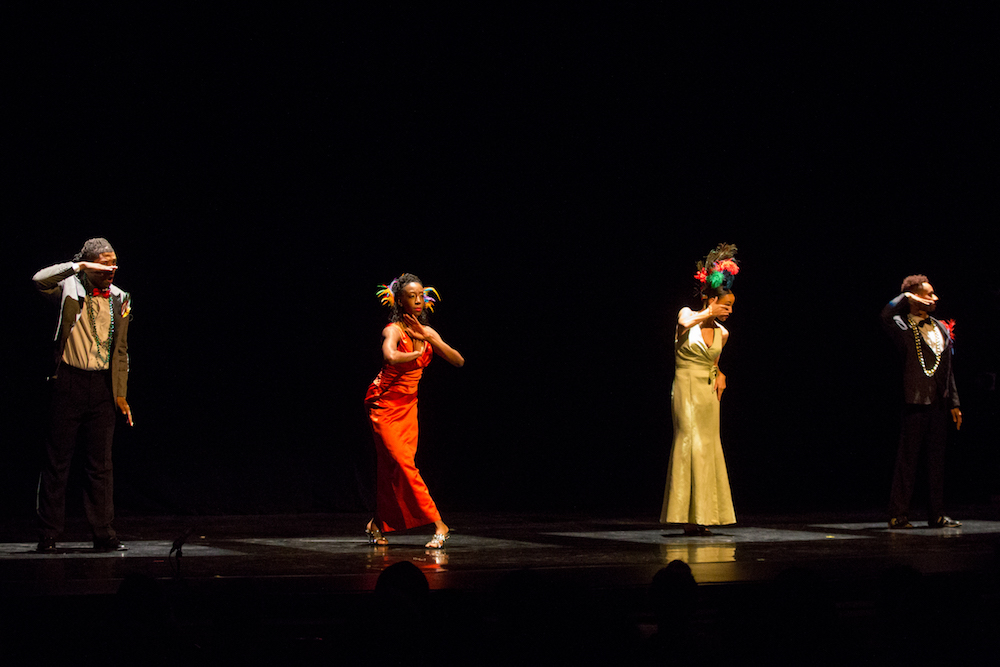
JA: The minstrels’ costumes also include cultural and historical information. Can you talk about that?
MJ: We watched a lot of cakewalk videos that were in black and white and I liked the clean lines as an opening moment. That became the first minstrel. It’s iconic. People can grasp: “Oh, it’s a minstrel.”
For the second minstrel (it’s actually the same dancer, Amelia Dietz) we added raffia and a Zulu sash for the Zulu ball.
The third minstrel is the “nexus minstrel.” You’ve got the Social Aid & Pleasure Club look and the Cape Town troupe look, and we put raffia around ankles to reflect Zulu dancers. The idea was to show the connection between the two: the raffia specific to the Zulu in South Africa and an umbrella representing an aspect of New Orleans and Cape Town.
The next time we see the minstrel, she comes out after a District Six monologue. The District Six monologue is a solo dancer [Chloe]: bare-chested, dancing to an interview sound score by a guy who grew up in District Six when they were doing the forced removals of people of colour. Chloe revisits the idea of the [New Orleans slave] auction block, but now it’s on South African land, as a Cape Malay person. At the end of her solo, the Cape Town minstrel comes out to clothe her and gives her a jacket.17
Later, we see the minstrel’s solo. This is the minstrel’s take on all these experiences, from New Orleans to the nexus to Cape Town. Then the entire troupe appears for the first time and she joins them.
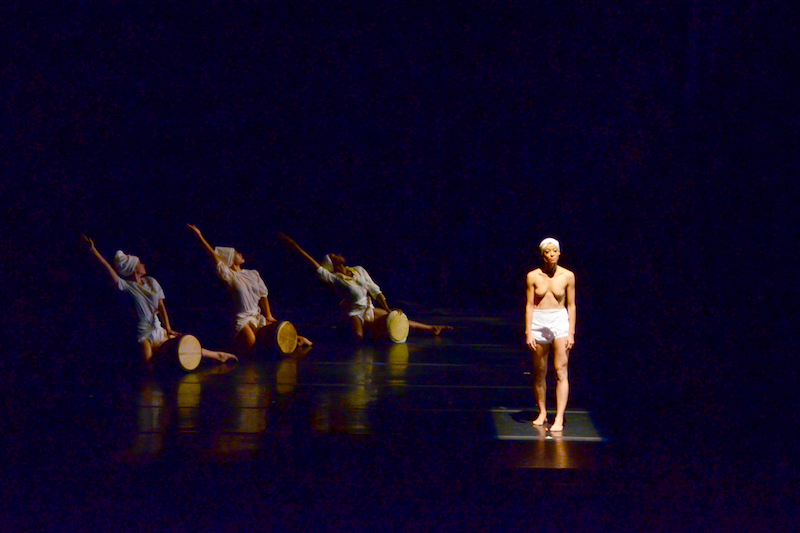
JA: What is the significance of the minstrel’s full, black body covering?
MJ: I started experimenting in Cape Town [in] 2012. I was invited to perform and choreograph for the ten days of national mourning for Nelson Mandela while in residence at UCT [University of Cape Town]. He actually died after I left, so I didn’t get to perform. When we realized that, it was like we were planning these artistic events, but he was still alive. So being the only American in the room, I felt a little out of place, kind of insensitive. Because I was dealing with that emotionally, I wanted to leave something for them. So, I choreographed “For Mandela and Martin”; it was the time of the [Trayvon] Martin/[George] Zimmerman verdict. I put the dancers in full black costuming, white hoodies, and that was—at least for me—a way to show that anyone can be Trayvon Martin. We all contributed to that situation. Anyone can be Nelson Mandela. Yes, it’s specific to young, black men, but at the same time, how can you see yourself inside of this experience? And the same thing was happening in South Africa. Black people historically have been targets.18
Again I played with a similar costume [in Bamboula] and thought: we can neutralize gender and race with solid colors. I was interested in telling the story so that, at a basic human level, you can find an entry point into the conversation. The context is rooted in black identity, black culture, blackness. The nature of systemic oppression is to keep us separated, right? Can you find your way into the conversation?
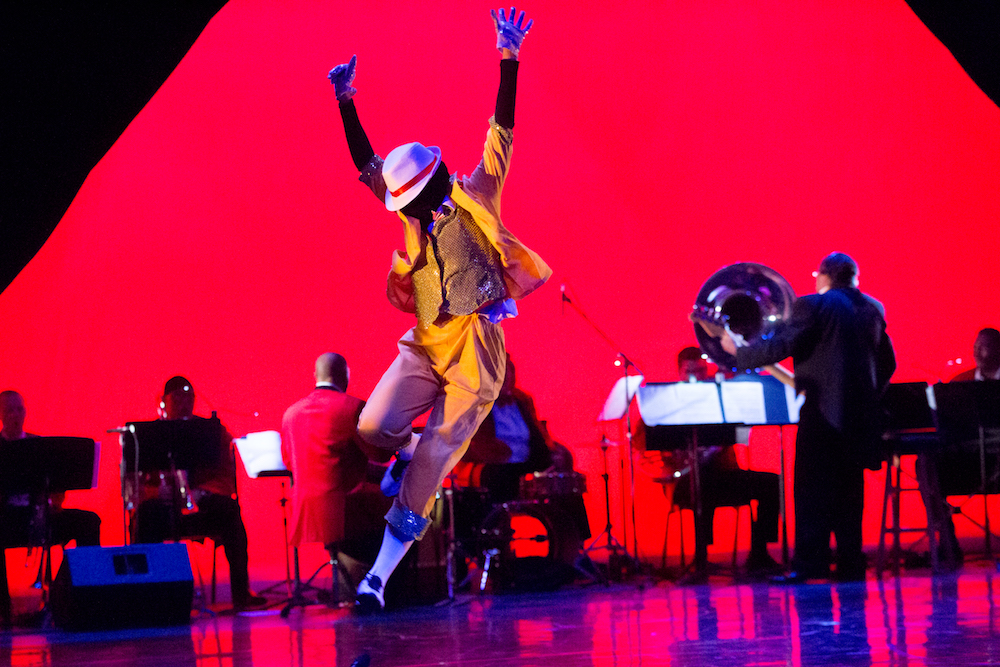
JA: Engaging the audience in the conversation, asking them to imagine that this could happen to anyone—the erasure becomes an opening up.
MJ: I just want to be clear. With this costuming, with neutralizing race and gender, I’m specifically talking about blackness. When I say that “this can happen to anyone,” I’m giving the audience the charge to be empathetic. Because of institutional racism, there are certain members in our society that are confined by a set of parameters—black and brown people. The charge to the audience is to feel what other people feel; find yourself inside the conversation so that you can feel the essence of the people, their culture, music, and languages. My hope is that if you can find your way inside of that, that will help us begin a real conversation on what it means to be human. And when we start to have those real conversations, maybe we will start making choices more like human beings.
A South Louisiana native, Millicent Johnnie has twenty years of experience working as a choreographer, director, and assistant professor in the performing arts. Johnnie is completing an MFA in film school at Florida State University, and recently choreographed Thoughts of a Colored Man, a Broadway-bound play produced by Syracuse Stage and Baltimore Center Stage.
Jennifer Atkins earned the Jules & Frances Landry Award for outstanding achievement in the field of southern studies for her book, New Orleans Carnival Balls. She co-edited the two-volume Perspectives on American Dance, co-chairs the national Popular Culture Association conference dance area, and teaches dance history at Florida State University.
Header image: NOLA All Up in My District Six, by Meagan Helman, courtesy FSU School of Dance.
Film credits:
Produced by Millicent Johnnie and Jennifer Atkins
Directed by Ashley James
Choreographed by Millicent Johnnie
Composed by Charles Vincent Burwell
Original Costume Design by December Mathinsen
Costumed by Currie Leggoe
Edited by Millicent Johnnie
Cinematography by Jennifer Petuch
Dancers: Ahmad Ratliff, Melissa Cobblah, Oliva Hopkins NOTES
- Bamboula: Musicians’ Brew was made possible through support from the National Dance Project, National Performance Network, and the National Endowment for the Arts; Millicent Johnnie, email message to author, April 8, 2018. The author would like to thank Leah Bailey and David Atkins for their invaluable assistance during this project, as well as the anonymous reviewers and Southern Cultures editors for their instrumental feedback.
- Social Aid & Pleasure Clubs began as Benevolent Associations (Mutual Aid Societies) in the early nineteenth century to provide medical care and funeral services for members, including funerals with music (popularly known as jazz funerals). They still sponsor brass bands and each organization hosts an annual second line parade. Club names tout their dancing mastery (like the Lady Buck Jumpers) or reveal their club turf (like the Big Nine, for the Lower Ninth Ward) or both (Westbank Steppers). For a second line example, see the opening of the Brothers of Change parade: “FOOTWORK: Brothers of Change 2012 second line featuring TBC Brass Band,” BigRedCotton, December 12, 2012, YouTube video, 7:50, https://www.youtube.com/watch?v=TOqJ4migVEc.
- Pre-Carnival day events include brass band Christmas choirs parading on Christmas Eve and Malay night choirs (Nagtroepe) parading on New Year’s Eve. Most musical competitions are held at the Athlone Stadium in the Cape Flats (where many klopse members live) the weekend following Carnival day. These competitions, which began in 1907, are choreographed group musical performances—battles for bragging rights; see “ALL Stars Cape Town Carnival 5 January 2019 Athlone Stadium/Minstrels/Klopse/Coons,” Jimmy De Kock, YouTube video, 10:26, https://www.youtube.com/watch?v=ovjGp7nTFCc; Francesca Inglese, “Choreographing Cape Town through Goema Music and Dance,” African Music: Journal of the International Library of African Music 9, no. 4 (2014): 130.
- Helen A. Regis, “Blackness and the Politics of Memory in the New Orleans Second Line,” American Ethnologist 28, no. 4 (November 2001): 756; Clarence A. Becknell, Thomas Price, and Don Short, “History of the Zulu Social Aid & Please Club,” http://www.kreweofzulu.com/history.
- For goema/New Orleans links, watch: “South African Jazz: The Ghoema,” Jazz at Lincoln Center’s JAZZ ACADEMY, September 30, 2014, YouTube video, 5:21, https://www.youtube.com/watch?v=StfYxD8LqYw.
- Benjamin Doleac, “Strictly Second Line: Funk, Jazz, and the New Orleans Beat,” Ethnomusicology Review 18 (2013): https://ethnomusicologyreview.ucla.edu/journal/volume/18/piece/699.
- Other Carnival practices employ blackface, including Colombia’s El Son de Negro and Panama’s Festival de Diablos y Congos. Though this broader context is beyond the scope of this interview, see Melissa M. Valle, “Burlesquing Blackness: Racial Significations in Carnivals and the Carnivalesque on Colombia’s Caribbean Coast,” Public Culture 31, no. 1 (2019): 5–20; and Renée Alexander Craft, When the Devil Knocks: The Congo Tradition and the Politics of Blackness in Twentieth-Century Panama (Columbus: Ohio State University Press, 2015); Zulu Social Aid & Pleasure Club, Inc., “Full Script—Official Press Release: NEW ORLEANS (2/13/19),” Facebook, February 14, 2019, https://www.facebook.com/ZuluSAP1909/posts/full-script-official-press-release-new-orleans-21319-blackface-minstrelsy-was-a-/2218617234856752/. Zulu’s explanation is not fully convincing for some, see Michelle Krupa, “The Black Leaders of an Iconic Mardi Gras Parade Want You to Know Their ‘Black Makeup is NOT Blackface,’” CNN, March 5, 2019, https://www.cnn.com/2019/02/16/us/zulu-new-orleans-blackface/index.html.
- Nadia Davids, “‘It Is Us’: An Exploration of ‘Race’ and Place in the Cape Town Minstrel Carnival,” in Routes of Blackface, ed. Catherine M. Cole and Tracy C. Davis, special issue, TDR 57, no. 2 (Summer 2013): 98.
- Ibid., “‘It Is Us,’” 87, 95, n2. The internationally acclaimed Christy’s Minstrels also visited in 1862. Of note, McAdoo first visited Cape Town in 1890 with his troupe, the Virginia Jubilee Singers, who performed African American spirituals. Denis-Constant Martin, Sounding the Cape: Music, Identity and Politics in South Africa (Somerset West, South Africa: African Minds, 2013), 84. Many of the troupe performers permanently settled in Cape Town, continuing to work in local musical and theatrical communities. Martin, Sounding the Cape, 82; Chinua Akimaro Thelwell, “Toward a ‘Modernizing’ Hybridity: McAdoo’s Jubilee Singers, McAdoo’s Minstrels, and Racial Uplift Politics in South Africa, 1890–1898,” Safundi 15, no. 1 (2014): 3, 5. Racial uplift politics, which emerged in postbellum America among middle-class African Americans, stressed “upward social mobility and improvement of the race”; Thelwell, “Toward a ‘Modernizing’ Hybridity,” 9. For McAdoo and his troupe, disrupting convention meant altering the minstrelsy format, wrestling with caricatures of people of color (through lectures about racialized experiences or deadpan deliveries), and even chastising white audience members when they displayed bad behavior at performances. His racial self-classification as coloured granted him access to this fluidity in South African culture but also inherently referenced black experiences. Daphne A. Brooks, Bodies in Dissent: Spectacular Performances of Race and Freedom, 1850–1910 (Durham, NC: Duke University Press, 2006), 8.
- Recent products taken off the market due to associations with blackface: Katy Perry’s Rue Face Slip On Loafers and Ora Face Block Heel Sandal (black leather shoes with red lips); Gucci’s black wool balaclava jumper that pulls up to the nose to reveal large red lips; and Prada’s Pradamalia monkey key chains and figurines. Recent school incidents of blackface include: a fraternity party at California Polytechnic State University in San Luis Obispo (April 2018); a man in blackface blatantly walking around the University of Oklahoma campus (January 2019); a female powder-puff football team competing in full blackface in Missouri (2014); a first grade teacher at her Iowa school Halloween party (October 2018); second graders at an Atlanta school using blackface masks while reciting Paul Laurence Dunbar’s poem “We Wear the Mask” for the 2018 Black History Month. Alan Blinder and Jonathan Martin, “Governor Admits He Was in Racist Yearbook Photo,” New York Times, February 1, 2019, https://www.nytimes.com/2019/02/01/us/politics/ralph-northam-yearbook-blackface.html. See also Cleve R. Wootson Jr., “The Lengthy History of White Politicians Wearing Blackface—and Getting a Pass,” Washington Post, February 16, 2019, https://www.washingtonpost.com/nation/2019/02/16/lengthy-history-white-politicians-who-wore-blackface-got-pass/?utm_term=.e6bedcf55aa5. Many Take ’Em Down NOLA (TEDN) activists are people of color. For TEDN’s stance on Zulu, see “Take Em Down NOLA Confronts Zulu Club’s Use on Blackface,” Take Em Down NOLA, March 20, 2019, http://takeemdownnola.org/updates/2019/3/20/take-em-down-nola-confronts-zulu-clubs-use-of-blackface. And Zulu’s taunting response: Janaya Williams, “In New Orleans, the Fight over Blackface Renews Scrutiny of a Mardi Gras Tradition,” NPR, March 3, 2019, https://www.npr.org/2019/03/03/699858084/in-new-orleans-the-fight-over-blackface-renews-scrutiny-of-a-mardi-gras-traditio. See also Maura Judkis, “A White Cocktail Industry Leader Wore Blackface at Mardi Gras. It Didn’t Go over Well,” Washington Post, March 6, 2017, https://www.washingtonpost.com/news/food/wp/2017/03/06/a-white-cocktail-industry-leader-wore-blackface-at-mardi-gras-it-didnt-go-over-well/?utm_term=.ad055216bf66. See also C. W. Cannon, “Behind the Zulu Blackface Flap: Liberal Guilt, Clueless Outsiders,” Lens, March 10, 2017, https://thelensnola.org/2017/03/10/behind-the-zulu-blackface-flap-liberal-guilt-clueless-outsiders/.
- Millicent Johnnie visited South Africa in 2010 as a Visiting Academic with the University of Cape Town; in 2012 she served as Southern Methodist University Assistant Professor, directing and choreographing West Side Story at the University of Kwa-Zulu Natal; and in 2015 as director/choreographer of the 2015 New England Foundation for the Arts project Bamboula: Musicians’ Brew with Cleo Parker Robinson Dance. The fleur-de-lis is a symbol ubiquitous throughout New Orleans, first appearing at the city’s founding (a fleur-de-lis flag flew until Spanish occupation) and more recently as iconic Saints football team logo. Governor Bobby Jindal signed legislation that designated the motif as the city’s official state symbol in 2008. Fleur-de-lis (French, meaning “flower of the lily,” but it can also refer to irises) has come to represent New Orleans’s pride in its French heritage—and staunch resilience post-Katrina—but it also has a complicated racial past. In antebellum Louisiana, escaped slaves, once caught and sentenced by court, were branded with the fleur before having their ears cropped. See Joe Lapointe, “Saints Aren’t the First to Call on Fleur Power,” New York Times, February 6, 2010, https://www.nytimes.com/2010/02/07/sports/football/07fleurdelis.html; and “Saints Fans Weigh in on the Fleur de Lis’ Association with Slavery,” Louisiana Weekly, January 7, 2019, http://www.louisianaweekly.com/saints-fans-weigh-in-on-the-fleur-de-lis-association-with-slavery/.
- Donald Harrison Jr. is the Big Chief of The Congo Square Nation Afro-New Orleans cultural group; see https://www.donaldharrison.com/bio.html.
- See Amma Y. Ghartey-Tagoe Kootin, “Lessons in Blackbody Minstrelsy: Old Plantation and the Manufacture of Black Authenticity,” TDR 57, no. 2 (Summer 2013): 102–122. For Zulu Social Aid & Pleasure Club blackface in Mardi Gras history, see Felipe Smith, “‘Things You’d Imagine Zulu Tribes to Do’: The Zulu Parade in New Orleans Carnival,” African Arts 46, no. 2 (Summer 2013): 22–31.
- “Bamboula is not Bamboozled” references Spike Lee’s 2000 satire Bamboozled, which explores American history and culture, racial stereotypes, and performance. See Ashley Clark, “Bamboozled: Spike Lee’s Masterpiece on Race in America Is as Relevant as Ever,” Guardian, October 6, 2015, https://www.theguardian.com/film/2015/oct/06/bamboozled-spike-lee-masterpiece-race-in-america.
- For this first iteration, Johnnie says, “We watched YouTube videos on how to apply clown makeup. We manipulated those [movements] to allow the physical hand gestures to travel through space.” For makeup tutorials, see NGTV, “NG Makeup Prep,” March 12, 2012, YouTube video, 13:41, https://www.youtube.com/watch?v=wggzfpdWhD8&feature=youtu.be; and JP M, “Applying Mime Paint,” March 16, 2011, YouTube video, 6:54, https://www.youtube.com/watch?v=0AElqKEPeBI&feature=youtu.be.
- Images of some of Zulu’s past Coronation Balls can be found in their club’s online gallery: http://www.kreweofzulu.com/gallery. Johnnie points out that Zulu’s team is focused on developing the creative, rather than administrative, elements of the production. Bamboula creative team members who attended the Zulu ball included Millicent Johnnie (writer, director, choreographer), Charles Vincent Burwell (composer and arranger), and Isaac Points (music director and arranger).
- For a concise explanation of the District Six forced removals under the apartheid government, see “District Six: Recalling the Forced Removals,” South African History Archive, February 11, 2010, http://www.saha.org.za/news/2010/February/district_six_recalling_the_forced_removals.htm.
- For descriptions of the memorial services honoring Nelson Mandela, see Robyn Curnow, “Nelson Mandela’s Funeral, Farewell Plans—a Day by Day Breakdown,” CNN, December 6, 2013, https://www.cnn.com/2013/12/06/world/africa/nelson-mandela-whats-next/index.html.

